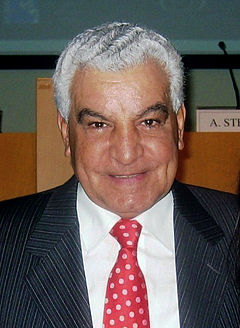Zahi Hawass
| Zahi Hawass زاهي حواس |
|
|---|---|

Hawass in Paestum, November 2006
|
|
| 1st Minister of Antiquities | |
|
In office January 31, 2011 – March 3, 2011 |
|
| President | Hosni Mubarak |
| Prime Minister | Ahmed Shafik |
| Preceded by | Office created |
| Succeeded by | Mohamed Ibrahim Ali |
|
In office April 5, 2011 – July 17, 2011 |
|
| Prime Minister | Essam Sharaf |
| Succeeded by | Mohamed Said |
| Personal details | |
| Born |
May 28, 1947 Damietta, Kingdom of Egypt |
| Nationality | Egyptian |
| Alma mater |
University of Pennsylvania University of Cairo Alexandria University |
| Profession | Egyptologist |
| Religion | Islam |
| Website | drhawass |
Zahi Hawass (Arabic: زاهي حواس; born May 28, 1947) is an Egyptian archaeologist, an Egyptologist, and former Minister of State for Antiquities Affairs. He has also worked at archaeological sites in the Nile Delta, the Western Desert, and the Upper Nile Valley.
Hawass was born in a small village near Damietta, Egypt. Although he originally dreamed of becoming an attorney, he obtained a bachelor of arts degree in Greek and Roman Archaeology from Alexandria University in Alexandria, Egypt in 1967. In 1979, Hawass earned a diploma in Egyptology from Cairo University. Hawass then worked at the Great Pyramids as an inspector—a combination of administrator and archaeologist. When he was 33 years old, Hawass was awarded a Fulbright Fellowship to attend the University of Pennsylvania in Philadelphia to study Egyptology, earning a master of arts degree in Egyptology and Syro-Palestinian Archaeology in 1983, and his PhD in Egyptology in 1987 from the Graduate Group in the Art and Archaeology of the Mediterranean World (AAMW), concentrating on "The Funerary Establishments of Khufu, Khafra and Menkaura During the Old Kingdom."
After 1988, Hawass taught Egyptian archaeology, history and culture at the American University in Cairo, and the University of California, Los Angeles. Hawass has described his efforts as trying to help institute a systematic program for the preservation and restoration of historical monuments, while training Egyptians to improve their expertise on methods of excavation, retrieval and preservation.
...
Wikipedia
